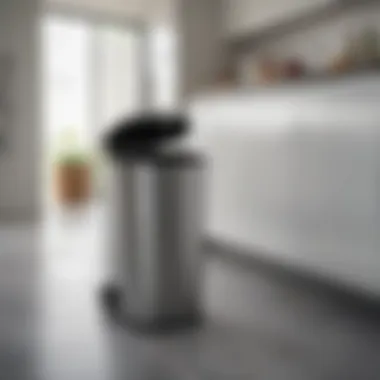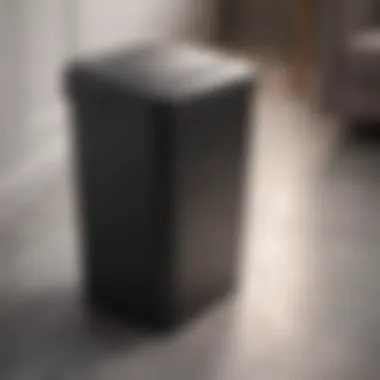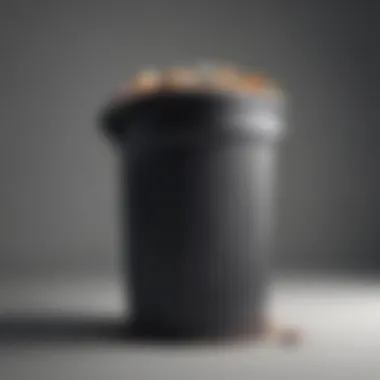Exploring Modern Trash Can Design and Utility


Intro
Furniture Design Styles
Overview of Popular Styles
When considering the design of trash cans, several styles stand out. Here are some popular trends:
- Minimalist: Characterized by clean lines and simple shapes, minimalist trash cans often come in muted colors like white, black, or grey. They prioritize form over function, making them perfect for modern interiors.
- Vintage: Nostalgia has its charm. Vintage-style cans, often made from metals and featuring intricate designs, add a touch of character to any kitchen or living space.
- High-Tech: With the advent of smart home technology, some trash cans even come with touch-free lids and sensors. These modern marvels are both functional and chic, appealing to tech-savvy homeowners.
- Eco-Friendly: More sustainable options are entering the market, often made from recycled materials or designed for composting. These cans cater to environmentally conscious consumers seeking to reduce their ecological footprint.
How to Mix and Match Styles
Finding the right trash can to complement your home’s aesthetic can feel challenging. Here are some thoughts on how you can successfully mix and match:
- Complement, Don’t Clash: If your kitchen is a blend of vintage and modern, look for a trash can that has a retro feel but utilizes contemporary materials.
- Focus on Color: Use a color palette that ties the trash can into the overall scheme of your home. Neutrals tend to work well across styles.
- Proportion Matters: Ensure that the size of the trash can fits the spaces you have. A large, bold can in a small nook can feel overwhelming, whereas a tiny one in a spacious area might get lost.
"A well-designed trash can not only looks good but also speaks volumes about your taste and lifestyle choices."
Practical Tips for Homeowners
Essential Buying Tips
Choosing the right trash can involves more than just aesthetics. Here are some key points:
- Size and Capacity: Evaluate your household’s waste production. A larger family may require more capacity.
- Functionality: Look for features like easy-to-open lids, foot pedals, or removable liners for hassle-free cleaning.
- Material Durability: Stainless steel is often preferred for its longevity and easy maintenance, while plastic options can be lighter and cheaper.
Maintenance and Care Guidelines
Keeping your trash can in tip-top shape doesn’t have to be a chore. Here are a few pointers:
- Regular Cleaning: Set a schedule to wash your trash can. This simple upkeep prevents odor build-up and keeps your home fresh.
- Use Liners: Utilizing trash liners can minimize direct contact with waste, making for easier cleanups.
- Check for Wear and Tear: Pay attention to any rust or cracks, which may signal it's time for a replacement.
By understanding the balance of form and function in modern trash cans, you can make informed decisions that not only serve your practical needs but also uplift the overall aesthetic of your living space.
Prologue to Modern Trash Cans
In the quest to harmonize beauty with utility, modern trash cans have garnered an unexpected yet crucial stature in home design. Once dismissed as mere containers for waste, these components have evolved into significant elements that reflect personal style, environmental consciousness, and functional prowess. Homeowners, designers, and DIY enthusiasts now recognize that trash cans do more than hold garbage – they play a key role in the aesthetic and practical aspects of living spaces.
Designers increasingly find themselves pondering not just how a trash can fits within the overall decor, but also how the right choice can elevate the ambiance of a room. The color, material, and style of these cans contribute to overall design harmony, acting as subtle statements about cleanliness and order in home maintenance. Thus, understanding various trash can options empowers individuals to make informed decisions that complement, instead of clash with, their spaces.
The Role of Trash Cans in Home Design
When discussing the role of trash cans in home design, one might initially overlook their impact. However, these items can truly accentuate or detract from the surrounding space. For instance, a sleek, brushed nickel trash can might uniquely complement a contemporary kitchen, while a vintage wooden model can enhance a rustic aesthetic. This intersection between functional design and decor is what makes trash cans vital to homeowners and designers alike.
- Form meets function: A well-designed trash can does not only look good but also serves a practical purpose. The key is to find the right balance between usability and style.
- Statements of personality: Different styles of trash cans might reflect the personality and values of the homeowner. An eco-friendly model might signal a commitment to sustainability, while a chic, high-end option may showcase a flair for elegance.
Evolving Perspectives on Waste Management
As discussions surrounding environmental issues continue to grow, the perspectives on waste management are also undergoing a transformation. No longer are trash cans just simple containers to hide waste; they have become symbols of our values towards sustainability and eco-friendliness. This shift in perspective influences not only the design choices that consumers make but also the manufacturers who strive to meet rapidly changing demands.
Consider the integrated recycling systems that many modern cans offer; they facilitate better waste disposal practices right at home. The acknowledgment of waste management importance fosters a convergence of aesthetics and environmental concern. It compels manufacturers to produce attractive and functional designs that help to encourage responsible waste habits among consumers.
"In the modern context, trash cans serve both decorative and functional roles, acting as guardian sentinels of order in our spaces while embodying the age-old truth that one man's trash is another man's treasure."
With the evolution of materials, from biodegradable composites to stainless steel, a bridge is built between the concept of waste and our values. As we explore the marriage of aesthetics and functionality, it becomes clear that the trash can has come a long way from just being a place to dispose refuse.
Aesthetic Considerations
In today's home design landscape, trash cans often escape the spotlight. However, the aesthetics of these functional items deserve more attention. When we toss something away, we're not just engaging in a simple act; we’re curating our space, shaping the visual narrative of our home. An attractive trash can can enhance the overall decor, serving both as a subtle accent and a practical necessity. There's definitely a growing awareness that even trash cans can be stylish, and this realization has led to a variety of innovative designs.
One significant benefit of aesthetically pleasing trash cans is their ability to complement the existing decor. For example, sleek models can fit seamlessly into modern kitchens, whereas ornate designs may enhance a vintage-themed space. A well-chosen trash can speaks volumes about the homeowner's taste and attention to detail. People tend to gravitate towards options that harmonize with their style, and many now prioritize aesthetics alongside functionality when shopping for these essential items.


Material Choices and Their Impact
Stainless Steel
Stainless steel trash cans have taken the design world by storm. Their key characteristic lies in their durability and sleek finish, which can elevate any setting. Not only do they resist rust and staining, but they also exude a contemporary vibe that fits well with various design styles. The unique feature of stainless steel is its resistance to odors—a no-brainer for kitchens where food waste may linger. However, they can have a downside due to fingerprints being easily visible, which may require more frequent cleaning.
Plastic
Plastic trash cans are a staple in the realm of waste management, known for their affordability and versatility. Their lightweight nature makes them easy to move, which is a welcome trait for households that may need to rearrange their spaces frequently. The primary advantage of plastic is its variety of colors and shapes, fitting into any design scheme without breaking the bank. On the downside, while they can be durable, they may not offer the same long-term sturdiness as metal or ceramic cans. Also, they can retain odors if not cleaned regularly, which can be a drawback.
Ceramic
Ceramic trash cans bring a touch of elegance to waste disposal with their ability to showcase artistic patterns and finishes. This material stands out because it can be beautifully designed to match any decor, acting almost as a decorative piece rather than just a container. A unique feature of ceramics is their ability to retain scents less than other materials, which is appealing in places like bathrooms. However, it’s crucial to note that ceramics can be quite heavy and fragile, leaving them susceptible to chipping or breaking.
Wood
Wooden trash cans integrate a natural aesthetic into living spaces, giving a warm, rustic feel that other materials might lack. Often made from treated wood, these cans can blend beautifully with earthy or organic decors. The whole vibe they give off can set a tone of sophistication, making them a unique choice. However, wood requires careful maintenance to prevent warping or damage from moisture and can, at times, be pricier than its plastic or metal counterparts.
Color and Finish Options
Matte vs. Glossy
When considering the finish of trash cans, the choice between matte and glossy is pivotal. Matte finishes lend a subtler, modern look, masking scratches and fingerprints better than their glossy counterparts. Moreover, they typically integrate beautifully with minimalist decor where understated elegance is key. Conversely, glossy finishes create a shine that can stimulate reflections and add a sense of brightness to a room. They tend to be easier to wipe clean but do show marks and smudges more readily, requiring regular upkeep.
Neutral vs. Bold Colors
Color selection can dramatically alter the presence of a trash can. Neutral colors—like whites, grays, and blacks—offer versatility and can seamlessly blend with almost any environment. They tend to evoke a sense of calmness and understated sophistication. On the other hand, bold colors make a statement, allowing trash cans to become conversation pieces or funky additions to a lively kitchen. The personal choice between the two often comes down to the existing color scheme and the desired impact.
Trends in Finishes
Current trends in finishes involve embracing industrial elements alongside organic touches. Metallic finishes paired with reclaimed wood provide a unique juxtaposition and showcase a blend of textures. This trend resonates with those leaning toward sustainable materials and eco-friendly design, often placing importance on aesthetics without sacrificing the planet’s welfare. However, these attractive finishes may also call for more careful maintenance compared to standard options, balancing beauty with practicality.
Functional Design Features
When it comes to modern trash cans, functional design features are as vital as aesthetics. Homeowners today are not just looking for something to stash their waste in. They want a trash can that complements their living space, is easy to use, and contributes positively to waste management. These functional elements tap into the pressing need for convenience while addressing environmental considerations, making them essential for optimal design.
Sensor-Operated Mechanisms
Sensor-operated trash cans are a game changer in the realm of waste disposal. Gone are the days of messy foot pedals or the need to wrestle with a lid. With a simple wave of the hand, these cans open automatically, allowing users to toss their rubbish without making contact. This is not just a bonus for convenience but also helps maintain hygiene, which is a significant factor in today’s health-conscious world.
Moreover, many of these sensor cans come with features like silent closing lids and airtight seals to keep odors contained. They are designed to accommodate various waste types, from kitchen scraps to bathroom waste, providing a seamless experience in different settings.
Several considerations come into play when looking at sensor-operated mechanisms. For instance, they often require a power source, which could limit placement options. Regular maintenance is also necessary to keep sensors functioning optimally, making it a good idea to evaluate both the ease of cleaning and battery replacement.
Recycling Options Integrated into Design
With the heightened awareness around sustainability, integrated recycling options are becoming more prominent in the market. Modern designs offer methods to easily separate recyclables from regular waste, encouraging environmentally responsible disposal.
Dual-Compartment Trash Cans
Dual-compartment trash cans have surged in popularity, thanks to their clever design that makes sorting waste intuitive. These cans usually have two sections: one for recyclables and another for general waste. Their standout feature lies in the simplicity; it helps users segregate waste effortlessly without needing multiple bins cluttering a space.
This dual functionality supports not only effective waste management practices but also aligns with eco-conscious living. It essentially reminds users to think twice before tossing items, fostering habits that can reduce landfill contributions. However, one might need to consider their size, as they can occupy more area than a standard single-bin can, which could be an issue in compact homes.
Sorting Systems
Sorting systems take the concept of waste separation a step further. These innovative designs can include multiple compartments that categorize waste not only by type but also by material. The idea resonates well with both designers looking for a functional and fine-looking addition to interiors, as well as homeowners who take pride in reducing their carbon footprint.
A key characteristic is that many systems offer clearly marked compartments, helping users identify where to place items at a glance. This ease of use is an appealing feature for families and those who might not be well-versed in recycling rules. However, it’s worth noting that the complexity of these systems may lead to confusion if one is not attentive.
In summary, functional design features in modern trash cans are pivotal not just for enhancing usability but also for fostering a culture of mindful waste disposal. Whether through sensor-operated mechanisms or creative recycling options, these elements align with contemporary lifestyle needs while aiding in environmental stewardship.
Choosing the Right Trash Can for Your Space


Selecting the proper trash can for your space involves more than just functionality; it intertwines with your aesthetic vision and practical needs. A trash can might seem like a mundane item, but its role is significant in both clutter control and maintaining a sense of order. When you choose wisely, you're not just picking a receptacle – you're choosing a utility that integrates seamlessly into your home or office. Everyone wants their environment to look sharp, and let’s face it, a well-chosen trash can can complement your design choices while keeping waste neatly contained.
Factors to Consider
Size and Capacity
Size and capacity are massively important when it comes to selecting a trash can. You wouldn't squeeze a square peg into a round hole! Think about how much waste your household generates or how busy a particular area might be. A small bin in a bustling kitchen can overflow faster than you can say 'clean up'. On the other hand, a bulky trash can may waste space in a cozy bathroom.
Typically, a 13-gallon can fits well in most kitchens, balancing size and practical use. In contrast, if you find yourself throwing away more than you anticipated, a larger option, perhaps 20 gallons or more, might be necessary. Knowing the right fit ensures a blend of utility and a tidy appearance without overwhelming your space.
Placement Location
Where you place your trash can can influence both its utility and aesthetic appeal. A cleverly placed can that matches your interior design can function without standing out like a sore thumb. For instance, hiding it in a cabinet might be ideal for the kitchen, while a decorative can could be a standout in a home office.
In addition, consider foot traffic. A trash can located in a busy area needs easy access, making a sensor-operated model an excellent choice for hands-free disposal. The right placement harmonizes functionality with style, reducing clutter and enhancing your space's overall feel.
Design Harmony with Surroundings
Design harmony with your surroundings involves selecting a trash can that accentuates the existing decor. If your kitchen features rustic wooden elements, a trash can in painted wood or a soft-toned finish can blend beautifully. Meanwhile, a sleek stainless steel bin may complement minimalist or contemporary designs.
Think about colors and styles that resonate with your theme and choices already in your environment. It’s about finding that sweet spot where functionality meets fashion. Opt for a trash can that enhances rather than distracts from the overall ambiance. A well-chosen can can work wonders in defined spaces where design matters as much as functionality.
Popular Styles for Different Areas
Kitchen
Kitchens are perhaps one of the most demanding environments for trash cans. You need a can that caters to the volume of waste produced, be it from food scraps or packaging. Consider a pedal-operated trash can - this makes throwing away waste a breeze without the need to touch the can itself. Also, materials like stainless steel offer durability against spills, while their sleek design keeps things looking neat. Additionally, dual-compartment models are gaining traction, allowing you to sort your recycling while cooking, which adds a much-needed layer of efficiency.
Office
In an office setting, the trash can often takes center stage. It needs to be subtly stylish, so it doesn't detract from the workspace but instead enhances it. Look for something compact that fits under a desk yet holds a decent capacity to handle daily paper waste and more. A can with a lid can also help keep things tidy and out of view, which is often appreciated in professional settings.
Moreover, incorporating waste dividing systems encourages recycling and environmental responsibility, something many companies are more focused on nowadays.
Bathroom
Bathrooms tend to be small, so a trash can for this space should be discrete, yet accessible. A stylish can with a lid can help contain odors and keep things looking sharp. Consider choosing smaller, more compact designs, also made from water-resistant materials. A pop of color, or even a unique pattern, can add a personalized touch while still fulfilling its function competently.
Outdoor Spaces
For outdoor areas, look for trash cans that can withstand the elements. Weather-resistant materials such as sealed metal or durable plastic hold up better under the beating sun or rain. Also, consider larger sizes or bins that incorporate separate compartments for recycling and composting.
Position them in convenient areas, such as near seating or play areas, to encourage proper waste disposal while maintaining a tidy outdoor space. These can enhance outdoor aesthetics while fulfilling their purpose effectively.
"Choosing the right trash can is essential. It reflects not only your commitment to cleanliness but also speaks volumes about your design sensibilities."
In summary, selecting the ideal trash can is a marriage between aesthetics and practicality. Considering the right size, suitable placement, and harmony of design ensures that your choice elevates your space while meeting the functional demands of daily life.
Maintenance and Care
In the realm of modern trash cans, maintenance and care often take a backseat to aesthetics and features, but making them a priority is essential. Regular attention to your trash can not only prolongs its life but also ensures that it remains a contributing element to your home decor rather than an unsightly eyesore. An overlooked trash can can become a breeding ground for odors, bacteria, and even pests. Thus, integrating a solid maintenance routine into your trash can practices is not just practical—it's fundamental.
The next subsections will unpack cleaning techniques tailored for a variety of materials, recognize preventive measures against unwanted odors, and share actionable steps to keep your space clean and tidy while extending the lifespan of your trash can.
Cleaning Techniques for Various Materials
For Stainless Steel
Stainless steel trash cans are seen in many kitchens today, and for good reason. They exude a sleek modernity that ties in perfectly with contemporary decor. One standout characteristic of stainless steel is its resistance to rust and staining, making it particularly resilient. To maintain its luster, a blend of mild dish soap and warm water is often recommended, followed by a thorough rinse.
While stainless steel is durable, it can subtly show fingerprints and smudges, which some might find bothersome. The unique feature of stainless steel in relation to odor control is that it resists absorbing smells, a major plus for maintaining a sanitary environment. However, it’s worth noting that using abrasive cleaners can scratch the surface, potentially leading to tarnishing over time.
For Plastic


Plastic trash cans have carved their niche by being lightweight and affordable. A key aspect of plastic is that it can come in a spectrum of colors, allowing homeowners to pick one that compliments their space. They are generally easy to wipe down with any all-purpose cleaner, making them a convenient choice.
However, while their affordability is a significant advantage, over time, some plastic may warp or lose its shape, especially under excessive heat. One unique characteristic of plastic is how some types can be treated to resist odors, but this can vary, so caution is advised with food waste storage.
For Wood
Wooden trash cans infuse decoration with a sense of warmth and homey vibes. This material brings character and charm, blending seamlessly into rustic or traditional decor. Nevertheless, wood can be more challenging to maintain than its synthetic counterparts; moisture can warp it if not cared for properly.
Given its porous nature, using a cleaner designed for wood is essential to avoid damaging the surface. A protective finish can help mitigate this risk, but over time wood can still become discolored. The unique feature of wooden trash cans is their ability to conceal odors slightly better than plastic, but they still require regular maintenance to prevent any lingering smells from taking hold.
Preventive Measures Against Odors
Preventive care can play a big role in prolonging the freshness of your trash can. Adopting habits that prevent bad smells helps maintain not just your receptacle, but the surrounding area as well.
Use of Liners
Choosing to use liners may seem trivial, but it significantly impacts odor control. Liners create a barrier between the trash and the can, which helps safeguard the material from stains and smells. The key characteristic of liners is that they can be disposed of and replaced easily, minimizing direct contact with any organic waste that may carry odors.
Using a high-quality liner helps in sealing unwanted smells, which is why these products are a common choice among homeowners. Though they can increase expenditure over time, the trade-off for a fresh-smelling kitchen can be worth it.
Regular Cleaning Practices
Implementing a schedule for cleaning your trash can is a cornerstone of odor prevention. Regularly washing the interior and exterior with a mixture of vinegar and baking soda can help neutralize any unwanted smells while also killing germs. The key characteristic of such a practice is its ability to offer an eco-friendly solution without resorting to harsh chemicals.
While it may seem tedious, a little maintenance can go a long way—making sure your trash can poitives the overall feel of your space. Neglecting regular cleaning, on the other hand, can lead to persistent odors, which can become an uphill battle to combat later on.
By honing in on these various cleaning techniques and preventive measures, homeowners can achieve a more hygienic environment, showcasing their modern trash cans as esthetically pleasing, functional pieces that are well-cared for without compromising on style.
Current Trends in Trash Can Design
The design landscape of trash cans is evolving quickly. No longer just a necessary evil, modern trash cans are becoming vital parts of our living spaces. As we look around, we see not only changes in materials and functionality, but also an increasing awareness of environmental impacts. This section will explore two major trends driving the current design of trash cans: sustainable materials and innovations in waste management.
Sustainable Materials and Eco-Friendly Options
People are now opting for trash cans made from sustainable materials. This shift is more than a mere trend; it reflects a growing consciousness regarding the environment. Materials such as bamboo, recycled metals, and bioplastics are gaining traction. For instance, a trash can crafted from recycled materials doesn’t just serve a purpose; it tells a story of sustainability.
The benefits of choosing eco-friendly options are manifold. Firstly, there’s the reduction of waste in landfills. Every piece of recycled material means less new production, which is better for our planet. Secondly, eco-friendly trash cans can enhance the aesthetic of a room. Imagine a stylish bamboo bin that adds an earthy touch to your kitchen. Not only does it look good, but it also aligns with eco-conscious values.
Innovations in Waste Management
The realm of trash management is not left untouched by technology. Smart trash cans and waste tracking technology are pushing the envelope further. These innovations not only streamline the disposal process but also help in better waste segregation and management, which is crucial in our waste-heavy lifestyles.
Smart Trash Cans
Smart trash cans represent a big leap into the future. Equipped with sensors, these devices can open automatically, reducing the need for physical contact. This quality is a game changer, especially in kitchens and bathrooms, where cleanliness is paramount. Some smart trash cans also come with voice commands, making them a convenient choice for many users.
A notable feature of smart trash cans is their integration with mobile apps. Users can monitor how often the can is filled and even receive alerts when it's time to take it out. This ensures no one is caught off guard with overflowing garbage. The only downside might be the initial cost, which can be steeper compared to traditional cans. However, the investment can pay off in convenience and hygiene.
Waste Tracking Technology
On a broader scale, waste tracking technology is advancing rapidly. This tech allows users to gain insights into their waste consumption. By tracking what you throw away, you can make smarter purchasing decisions, ultimately reducing waste. This technology is particularly beneficial for businesses that aim to improve recycling rates while minimizing waste disposal costs.
Unique features include smart bins that can analyze the contents and provide data on types and quantities of waste generated. The insights lead to informed actions that benefit both the environment and your wallet. However, while integrating these systems can be complex and may require some training, the long-term benefits are significant.
"The intersection of functional design and environmental consciousness is where modern trash can designs are heading."
Incorporating these trends into our lives enhances not just the aesthetic quality of our surroundings but also promotes sustainable living. As designers and homeowners look to strike a balance between beauty and function, understanding these trends offers insight into making informed choices in trash can selection. Modern designs now emphasize not just how trash cans look but also how they operate within our homes and influence our habits.
Finale
As we wrap up our exploration of modern trash cans, it's essential to highlight the significance of blending functionality and aesthetics. While often underestimated, the trash can serves dual purposes that extend beyond waste disposal. It acts not just as a receptacle for refuse, but as a crucial player in maintaining the harmony and ambiance of your home. Integrating these aspects speaks volumes about your holistic design philosophy.
The Importance of Integrating Functionality and Aesthetics
In the world of interior design, every piece matters, from the grandest fixtures to the smallest items like trash cans. The importance of integrating functionality and aesthetics lies in its influence on everyday life. Here are several key points to consider:
- Visual Appeal: A well-chosen trash can can elevate the overall look of a space. Instead of being an eyesore, it can blend seamlessly with your decor, whether it's in the kitchen or bathroom. Imagine a sleek stainless-steel can that complements your modern appliances or a ceramic option that adds a vintage touch.
- Utility without Compromise: Today's trash cans come equipped with innovative features that facilitate ease of use. Sensor-operated lids, for instance, offer a hygienic solution while allowing quick disposal of waste without contact. These designs ensure that functionality does not lag behind aesthetics.
- Increased Efficiency: Effective waste management requires convenience. Choosing a trash can with compartments for recycling fosters an organized approach to waste generation. This not only simplifies waste separation but encourages more sustainable practices within the household.
- Maintenance: A stylish trash can that is simple to clean and manage enhances the tactical aspect. This contributes to a longer-lasting product, ultimately saving both time and dollars. Choosing the right material can significantly ease the burden of upkeep.
- Emotional Connection: Aesthetics play a profound role in our interactions with objects. A trash can that resonates with your taste might spark a subconscious sense of pride, reinforcing a commitment to cleanliness and order.
"Design is not just what it looks like and feels like. Design is how it works." - Steve Jobs
Ultimately, as designers, retailers, or homeowners, recognize that every detail counts in creating an environment that is both functional and visually pleasing.















